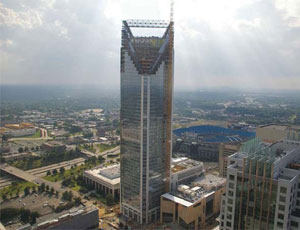The new year will likely bring considerably more pain to contractors and designers working in the Southeast Construction region, especially as firms focused on a still-declining commercial sector work off their thinning backlogs. Companies fortunate enough to be working in publicly funded markets should start to see some improvement in 2010, however.

That’s the opinion of McGraw-Hill Construction, publisher of Southeast Construction, in its forecast for the four-state region of Florida, Georgia, North Carolina and South Carolina. The company expects the Southeast region to experience a 10% improvement in the overall value of new contracts in 2010, for a cumulative total construction figure of $66.4 billion in project starts. That compares to the $60.2 billion the company estimates for 2009.
McGraw-Hill Construction expects its three broad construction categories—nonresidential, residential and nonbuilding—to all avoid further declines in 2010. Most notably, the long-moribund residential market is now forecast to reawaken somewhat, with a 16% overall increase predicted. Residential is expected to total about $22.6 billion, up from 2009’s estimate of $19.5 billion.
The Southeast’s nonbuilding sector—which includes roads, bridges and other infrastructure—is forecast to grow by 20% during the year, mostly the result of continuing spending from the American Recovery and Reinvestment Act, aka the “federal stimulus.” That will bring this category to a roughly $19.3-billion total, up from 2009’s $16.1-billion tally—and the second-highest annual total within the past five years.
The nonresidential market will remain problematic at best, however. Though McGraw-Hill expects this Southeast sector to remain flat overall, for a $24.6-billion total, many of its subsectors will continue to decline.
For example, commercial and industrial projects will decline 8% overall to tally just $8.3 billion, or roughly one-third the amount this category generated in 2007.
Jennifer Coskren, senior analyst with McGraw-Hill Construction’s Analytics Group, says that 2010 will be mostly more bad news for contractors and designers focused on private-sector construction.
“The private sector is likely to have another tough year in 2010, as private funding remains elusive and costly,” Coskren says. “The federal government’s attempts to shore up commercial real estate have been small relative to the efforts being exhausted on the residential side.
“Stress testing and greater equity requirements were forced on the larger financial institutions, but it has been the smaller, regional banks where a large share of the commercial funding took place and whose balance sheets are the most troubled.
“Unfortunately, with commercial real estate loans performing so poorly, it is unlikely that the financing spigot will flow freely in 2010 via either large or small banks. Consequently, we are expecting the private sector to remain quiet until at least 2011.”
The positive notes for 2010 will instead rest in the public sector.
| Millions of Dollars | 2003 | 2004 | 2005 | 2006 | 2007 | 2008 | Forecast 2009 | Forecast 2010 | 2008- 09 % Chg | 2009- 10 % Chg |
|---|---|---|---|---|---|---|---|---|---|---|
| Total Construction | 98,663 | 116,475 | 136,647 | 130,371 | 116,374 | 79,332 | 60,165 | 66,439 | -24% | 10% |
| Nonresidential Construction | 23,026 | 25,228 | 27,384 | 30,675 | 39,813 | 31,791 | 24,548 | 24,571 | -23% | 0% |
| Commercial & Industrial | 10,421 | 12,533 | 13,437 | 14,624 | 24,145 | 15,370 | 9,030 | 8,275 | -41% | -8% |
| Stores & Shopping Centers | 3,591 | 4,033 | 4,179 | 4,427 | 5,594 | 4,347 | 2,420 | 2,399 | -44% | -1% |
| Office Buildings | 2,953 | 3,369 | 3,232 | 3,999 | 6,151 | 3,853 | 3,030 | 2,554 | -21% | -16% |
| Hotels & Motels | 526 | 855 | 896 | 1,261 | 2,297 | 2,162 | 717 | 665 | -67% | -7% |
| Other Commercial Buildings | 2,661 | 3,531 | 4,154 | 4,220 | 4,736 | 3,381 | 1,547 | 1,501 | -54% | -3% |
| Manufacturing Buildings | 691 | 746 | 976 | 717 | 5,366 | 1,627 | 1,314 | 1,155 | -19% | -12% |
| Institutional Buildings | 12,605 | 12,695 | 13,947 | 16,052 | 15,668 | 16,421 | 15,518 | 16,296 | -5% | 5% |
| Education Buildings | 5,734 | 5,556 | 6,164 | 7,177 | 7,594 | 7,277 | 6,156 | 6,438 | -15% | 5% |
| Healthcare Facilities | 1,880 | 2,678 | 3,254 | 3,145 | 2,859 | 2,681 | 2,561 | 2,526 | -4% | -1% |
| Other Institutional Buildings | 4,991 | 4,460 | 4,530 | 5,730 | 5,216 | 6,463 | 6,801 | 7,332 | 5% | 8% |
| Residential Construction | 61,983 | 76,899 | 94,692 | 83,754 | 55,735 | 31,674 | 19,529 | 22,561 | -38% | 16% |
| Single Family | 51,743 | 63,447 | 76,639 | 67,290 | 44,177 | 25,358 | 16,877 | 20,099 | -33% | 19% |
| Multifamily | 10,239 | 13,452 | 18,053 | 16,463 | 11,558 | 6,317 | 2,652 | 2,461 | -58% | -7% |
| Nonbuilding Construction | 13,654 | 14,348 | 14,571 | 15,942 | 20,826 | 15,866 | 16,088 | 19,307 | 1% | 20% |
| Public Works | 11,641 | 13,174 | 13,357 | 15,553 | 18,110 | 13,991 | 13,105 | 17,559 | -6% | 34% |
| Streets & Bridges | 5,510 | 6,002 | 6,261 | 6,977 | 8,211 | 5,592 | 6,120 | 8,481 | 9% | 39% |
| Environmental Public Works | 3,617 | 4,137 | 3,968 | 4,315 | 5,538 | 5,689 | 4,119 | 4,770 | -28% | 16% |
| Other Public Works | 2,514 | 3,035 | 3,128 | 4,261 | 4,361 | 2,710 | 2,865 | 4,308 | 6% | 50% |
| Electric Utilities | 2,013 | 1,174 | 1,214 | 389 | 2,717 | 1,875 | 2,983 | 1,748 | 59% | -41% |
“Our estimates are calling for another strong year for public in 2010 before a retrenchment begins in 2011,” Coskren says. “The pipeline is still relatively full and several projects in the planning stages are set for a 2010 start date.”
Some of these projects include the $140-million Children’s Courthouse in Miami, a Special Forces Complex at...



Post a comment to this article
Report Abusive Comment